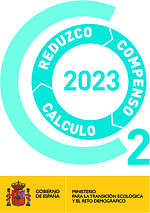Environmental action line
We recognize the importance of joining forces and implementing measures to adapt to and mitigate climate change, in addition to sponsoring initiatives to protect and raise awareness of biodiversity.

Environmental footprint
-
Financed emissions
The entity's efforts are focused on supporting its clients through sustainable transition advisory services, financing the development of new, less emission-intensive technologies, and thereby assisting them in their transformation, decarbonization, and efficiency improvement processes.
-
Decarbonization objectives As part of its focus on sustainability as a priority, ABANCA has set decarbonization targets for its loan portfolio by 2030 for the most CO2-intensive industries. These targets are defined in terms of intensity rather than exposure reduction (except for Coal), which demonstrates the entity's commitment to continue supporting its clients in a sustainable transition.
This also responds to its commitment to address the climate emergency and its membership in the Net-Zero Banking Alliance (NZBA), which aims to achieve the decarbonization of credit and investment portfolios by 2050. Compliance with this commitment has been approached with a gradual adoption strategy: in December 2022, emission reduction targets were established for the Steel, Cement, and Aviation sectors, along with a 2030 exit plan for Coal financing. In December 2023, decarbonization targets for the Fossil Fuels, Aluminum, and Automotive portfolios were published.
The publication of these targets for the most significant sectors was completed in June 2024, when ABANCA established new intermediate targets and committed to emission reductions by 2030 in two key sectors: the electricity generation sector and the residential real estate sector. ABANCA committed to reducing the carbon emission intensity of its loan portfolio between 2023 and 2030 by 34% for the electricity sector and 17% for the residential real estate sector.
In this way, ABANCA has expanded its published decarbonization pathway to a total of nine sectors.
In sectors such as agriculture, the limited maturity of global methodologies and the low availability of homogeneous and comparable data currently make it difficult to set quantitative decarbonization targets. However, the entity actively monitors its portfolio in this sector through ABANCA Agro, supporting clients in their transition towards a more sustainable model, paying special attention to issues such as their adaptation to the new CAP (Common Agricultural Policy), which is more demanding in this regard and enables the agricultural sector to fulfill its functions by providing benefits not only for the agri-food system but also for society, such as environmental conservation and the fight against climate change, and the modernization of irrigation systems.
For the maritime transport sector, the diversity of vessels financed in ABANCA's portfolio and the long useful life of the assets currently make it difficult to set decarbonization targets. Nevertheless, ABANCA Mar continues to work on supporting the sector with a focus on improving energy efficiency through promoting the financing of fleet renewals and biodiversity conservation.
The decarbonization pathway set by ABANCA covers a significant part of its portfolio and contributes to the goal of combating climate change. The entity's strategy involves deepening the monitoring of these targets, strengthening engagement with clients, and channeling funds towards activities that contribute to the decarbonization of the economy.
This decarbonization pathway has been approved by the entity's highest governing body, the Board of Directors, which monitors progress (updated in 2025).
*Base year 2021 for the steel, aviation, and cement sectors; 2022 for the fossil fuels, automotive, and aluminum sectors; 2023 for the electricity generation and residential real estate sectors.
» ABANCA has adopted a gradual approach to publishing these targets, which allows the entity to adapt its objectives to ongoing changes in the regulatory framework and the availability of information published by major emitters. These decarbonization pathways will be reviewed as more companies publish their carbon footprint data and as the reference methodologies are refined. Furthermore, the calculation of alignment metrics has been carried out using currently available methodologies. It is important to highlight the limitation in accessing sufficient and adequately granular information.
» In this context, ABANCA has participated in a sectoral project coordinated by AEB, CECA, and UNACC, involving other Spanish entities. The goal was to establish a common methodology and tool for calculating CO2 emissions and reduction targets.
» The reduction targets follow emission intensity metrics per unit of production, with starting points in 2021, 2022, and 2023, and a 2030 target for all nine sectors (among those identified by the NZBA as most intensive). These metrics follow the Sectoral Decarbonization Approach, which incorporates certain elements of PACTA (Paris Agreement Capital Transition Assessment).
» Following the EBA's request for Pillar III ESG templates, and regarding the 2022 publication, the CNAE criteria defining the different sectors have been aligned with Template 3 of that report. This redefinition led to a slight variation in the base year intensity for the steel sector, from 0.832 to 0.790 tCO2/t-steel.
» In 2025, due to the incorporation of portfolios from Eurobic, the starting point for the electricity generation sector's decarbonization target will be revised, though the ambition of the goal remains, with a 34% reduction by 2030.
» The 1.5°C scenarios have been used as a reference, specifically the International Energy Agency's net-zero emissions scenario and the calculation methodology developed by the Partnership for Carbon Accounting Financials (PCAF). This initiative aims to establish an international methodology for measuring and disclosing financed greenhouse gas emissions by banks and investors. For the residential mortgage portfolio, the Net Zero by 2050 scenario has been considered the base scenario, further specified with information from the Carbon Risk Real Estate Monitor (CRREM), whose data is extracted from the IEA.
» It is important to note that the 2030 decarbonization targets are not equivalent to an expected linear reduction between intermediate years; therefore, value fluctuations may occur in intermediate years without implying a failure to meet the target.
» This disclosure does not include the public sector or the fixed income and equity portfolios.
» More information on actions contributing to ABANCA's transition and that of our clients is included in the Consolidated Non-Financial Information Statement and Sustainability Information, as well as information on exposure to various sectors with decarbonization targets contained in the prudential relevance report templates.
-
-
Operational carbon footprint
Our commitment to the environment leads us to identify, manage, and implement measures to reduce our environmental footprint and foster the sustainable consumption of resources.
-

Strategic Carbon Footprint and Environmental Plan The Strategic Carbon Footprint and Environmental Plan acknowledges the achievements of the previous stage, such as emissions reduction, improvements to the energy monitoring system, and decreased consumption, among others, and establishes new objectives. This is with the purpose of ensuring efficient and sustainable management and use of energy and environmental systems, as outlined in the Energy and Environmental Policy, as well as in accordance with the commitment to the environment detailed in the Sustainability Policy.
-

Measurement and reduction
The entity set the objective of becoming a carbon-neutral organization in its own operations before 2024. An independent external party annually verifies the scope 1, 2, and 3 carbon footprint under an operational control approach, in accordance with the methodological requirements of the GHG Protocol.
These actions have been recognized with the "Calculo y Reduzco" (Calculate and Reduce) label from the Spanish Office for Climate Change for the carbon footprints of 2019, 2020, 2021, 2022, and 2023.
-

Compensation
ABANCA holds the "Compenso" (I Offset) label from the Spanish Office for Climate Change for the emissions of fiscal years 2020, 2021, 2022, and 2023.
We support the planting of native species in Galicia (ecologically adapted conifers) in degraded forest areas that require restoration due to being affected by wildfires or natural disasters. To this end, we collaborate with the expert team of the ARUME Foundation and the Galician Forestry Association. This initiative allows us to advance in our goal of offsetting remaining emissions, which has the 'Compenso' label from the Spanish Office for Climate Change.
In 2023, 93.10 hectares of land were restored, with the planting of nearly 80,000 trees, allowing us to surpass 550,000 trees planted since the collaboration began in 2020.
-

Energy efficiency
Ourstrategic energy efficiency planfor is intended to offer guidelines for achieving greater control over energy consumption, by simplifying its management and identifying where reductions are being made in our energy consumption and CO2 emissions.
Pocomaco Renewable Energy Generation Project
Within the framework of our plan and commitment to energy efficiency, ABANCA has developed a renewable energy implementation project in A Coruña. The objective of the initiative is to increase our photovoltaic energy production for self-consumption.
The project included the installation of 664 solar panels on the roofs of five buildings owned by the bank located in this industrial park in A Coruña.
Installations have been carried out on the roofs of the G9, H1, F12, C10 and D5 archive and warehouse buildings, with an estimated annual electrical production of 414,671.11 kWh, thus avoiding the emission of 148 tons of CO2 per year.
ABANCA CORPORACIÓN BANCARIA S.A. was the beneficiary of 5 subsidies from INEGA, a project included in the incentive programs 1, 2 and 3 linked to self-consumption and storage in the service sector and in other productive sectors, within the framework of the Recovery plan, Transformation and Resilience, financed by the European Union –NextGenerationEU.
Check here the information related to these subsidies.
All the electricity that we consume comes from 100% renewable sources, in this sense ABANCA has renewed its agreement with Endesa, to cover most of the entity's electricity demand with renewable energy of Galician origin for the next years.
-
-
Circular economy
Circular economy and proper waste management are key factors in contributing to saving raw materials and ensuring economic sustainability as they have a positive impact on the conservation of natural resources and ecosystems.
-

Redes vivas (Living Nets) The project was started to recover the tons of nets that end up in the sea, contaminating the marine ecosystem and affecting all of society, especially the fishing industry. This initiative gives a second life to all those kilos of ghost nets, which, with the help of craftsmen and the dedication of net-menders, are placed on the football fields and sports grounds of the clubs in our Basic Sports program.
-

Zero waste
The new waste management policy focuses on the points of generation and contributes to the advancement of the circular economy by prioritizing the reuse and recycling of materials. This initiative involves the source separation of generated waste into fractions that are managed by authorized operators, thereby aiming to utilize waste as raw material for new processes.
We have achieved the Zero Waste certification granted by AENOR for our corporate headquarters.
-

Electronic waste
We are making progress in the appropriate treatment of electronic waste, seeking to give it a second life and thereby reduce its environmental impact. In this reuse process, a life cycle assessment is conducted to evaluate the environmental burdens associated with a product, taking into account its complete cycle.
ABANCA offers its clientele the option to recycle expired financial cards through its network of automated teller machines.
-










